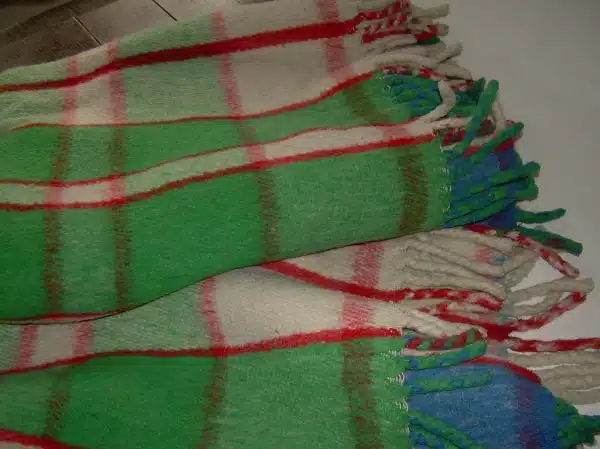Wool is a natural fiber that has been used for centuries to create warm and cozy blankets. With proper care and maintenance, wool blankets can last for many years and provide warmth and comfort throughout the seasons. However, improper cleaning and handling of wool blankets can lead to damage, shrinkage, or loss of shape.
As a textile care expert, it is essential to educate the public on the proper care and cleaning methods for wool blankets. The purpose of this article is to provide helpful tips on how to clean and care for wool blankets. Whether you are a homeowner looking to maintain your wool blanket’s quality or a caregiver in charge of caring for multiple wool blankets, this guide will provide useful information on how to prolong the lifespan of these cherished textiles while keeping them fresh and clean.
Understanding Wool As A Fiber
Wool is a natural fiber that has been used for centuries in the textile industry. It is derived from the fleece of sheep and other animals such as alpaca, cashmere, and mohair. Wool fibers have unique properties that make them highly sought after for their warmth, durability, and breathability.
Wool fiber properties include its ability to absorb moisture up to 30% of its weight without feeling damp. This allows wool garments to regulate body temperature by wicking away sweat from the skin and evaporating it into the air. Wool also has a natural crimp that creates tiny pockets of air, which traps heat and provides insulation even when wet.
Wool fiber characteristics also make it resistant to wrinkles, flames, static electricity, and odors. Wool fibers are naturally elastic and can stretch up to 50% of their length without breaking or losing shape. These properties make wool blankets an ideal choice for those looking for a warm and durable bedding option that requires minimal care. With these unique features of wool fibers in mind, let us explore the benefits of using wool blankets in your home.
Benefits Of Using Wool Blankets
A wool blanket is like a warm hug on a chilly day. Soft to the touch, yet durable and long-lasting, it can wrap you up in comfort for years to come. Wool blankets have been used by humans for centuries due to their insulating properties and natural moisture-wicking abilities. They are an excellent choice for anyone looking for a cozy and eco-friendly alternative to synthetic materials.
Benefits of Using Wool Blankets:
- Warmth: One of the primary benefits of wool blankets is that they provide excellent insulation, keeping you warm even on the coldest nights.
- Durability: Wool is a naturally strong fiber that can withstand wear and tear over time. This means that wool blankets are long-lasting and can be passed down from generation to generation.
- Moisture-wicking: Unlike synthetic materials that trap moisture against your skin, wool wicks away moisture naturally, keeping you dry and comfortable all night long.
As a textile care expert, I highly recommend investing in a high-quality wool blanket. Not only do they offer superior warmth and durability compared to alternatives such as cotton or polyester, but they also have natural moisture-wicking properties that make them ideal for year-round use. Plus, wool is a sustainable material that is biodegradable and renewable, making it an eco-friendly choice for those who care about the environment.
Next up, we will explore the different types of wool blankets available on the market today. From merino to alpaca, each type offers unique features and benefits that make them worth considering when choosing the perfect blanket for your home.
Types Of Wool Blankets
Wool blankets come in different types, and it is essential to differentiate between natural and synthetic wool blankets. Natural wool blankets made from the fleece of sheep or lambs are more durable and breathable than synthetic ones. They are also naturally hypoallergenic, making them ideal for people with allergies. On the other hand, synthetic wool blankets are cheaper and easier to care for as they are machine-washable.
Choosing the right type of wool blanket is crucial in ensuring that you get value for your money. If you live in a cold climate, go for thick wool blankets with high insulation properties. However, if you live in a warm climate, lightweight wool blankets with moisture-wicking properties will be ideal. Additionally, consider the size of the blanket and whether it fits your bed or couch perfectly.
Proper care for wool blankets is vital in maintaining their quality and longevity. Some common mistakes that people make include washing them in hot water or using harsh detergents that can damage the fibers. It is also important to air-dry wool blankets instead of tumble-drying them as this can cause shrinkage. By avoiding these mistakes and following proper care instructions, your wool blanket can last for years without losing its softness or warmth.
As much as choosing the right type of wool blanket is essential, taking good care of it ensures that it lasts longer while maintaining its quality. In the next section, we will discuss some common mistakes people make when caring for their wool blankets and how to avoid them.
Common Wool Blanket Care Mistakes
Proper wool storage and cleaning are crucial in maintaining the quality and longevity of wool blankets. Unfortunately, many people make mistakes when it comes to caring for their wool blankets. These errors can cause damage to the fabric, leading to premature wear and tear.
One common mistake is failing to store wool blankets correctly. Wool should be stored in a cool, dry place away from direct sunlight. Exposure to heat and light can cause damage to the fibers, leading to discoloration and weakening of the fabric. Additionally, storing wool with mothballs or cedar chips can be harmful as these substances contain chemicals that can cause discoloration or even holes in the fabric.
Another common wool cleaning mistake is using hot water or harsh detergents when washing your blanket. Wool is delicate and requires gentle handling during cleaning. High temperatures can cause shrinkage and damage to the fibers, while harsh detergents can strip the natural oils from the fabric, leaving it dry and brittle. It’s important to use a mild detergent specifically designed for wool fabrics and wash your blanket in cold water.
Properly caring for your wool blanket means avoiding these common mistakes while also taking proactive steps towards keeping it clean. In the next section, we’ll discuss how you can prepare your wool blanket for cleaning so that you can keep it looking its best for years to come.
Preparing Your Wool Blanket For Cleaning
Common wool blanket care mistakes can lead to damage and reduce the longevity of your blankets. It is essential to take good care of your wool blankets to keep them clean, fresh, and soft for years. One of the most common mistakes is not inspecting your wool blanket before cleaning it.
Before cleaning your wool blanket, you should perform a pre-cleaning inspection. Look for any stains, holes, or tears that may require special attention during cleaning. For instance, if you find a stain on your wool blanket, use a mild detergent solution to remove it gently. Ensure that you avoid harsh chemicals like bleach that may damage the wool fibers.
Proper storage is also another critical aspect of caring for your wool blankets. When storing them, ensure that they are clean and dry to prevent mold growth and insect infestations. You can store them in a cool and dry area away from direct sunlight, as exposure to sunlight can cause fading or discoloration.
- Wool blanket storage tips:
- Store in an acid-free container or bag
- Add cedar blocks or lavender sachets to deter moths
- Avoid stacking too many blankets on top of each other
Taking good care of your wool blankets will help maintain their quality for years. In the subsequent section, we will discuss how to hand wash your wool blanket effectively without causing any damage or shrinkage.
Hand Washing Your Wool Blanket
When it comes to caring for your wool blanket, hand washing is the preferred method. Start by filling a tub or sink with lukewarm water and adding a small amount of gentle detergent made specifically for wool. Gently swirl the water to create suds and then add your blanket, being careful not to agitate too much as this can cause felting or shrinkage. Let the blanket soak for 5-10 minutes, then gently swish it around in the soapy water before draining the tub.
Once you have drained the soapy water, rinse your wool blanket thoroughly in cool water until all soap residue is gone. Do not wring out your blanket as this can also lead to felting and distortion of the wool fibers. Instead, gently squeeze out excess water in sections by pressing between towels or rolling up in a towel and pressing down.
When it comes to drying your wool blanket, avoid direct sunlight and high heat as this can cause shrinkage and damage to the fibers. Instead, lay your clean wool blanket flat on a clean surface like a bed or table with good air circulation. Flip it occasionally until fully dry. Once dry, store your wool blanket in a cool, dry place away from direct sunlight and moisture. Avoid folding or hanging for prolonged periods of time as this can cause creases that are difficult to remove.
Transition: Now that you know how to properly care for your wool blanket through hand washing techniques, let’s explore how machine washing can affect its quality and durability over time.
Machine Washing Your Wool Blanket
- Pre-washing is an important step in properly caring for a wool blanket, as it helps to remove any surface dirt or debris before washing.
- The type of detergent used to wash a wool blanket is crucial, as using detergents containing bleach or optical brighteners can damage the fabric.
- Wool blankets should be washed on a gentle cycle, using a detergent specifically designed for wool or other delicate fabrics.
- After washing, wool blankets should be laid flat to dry rather than placed in the dryer, as the heat from the dryer can damage the fibers.
- To minimize shrinkage, wool blankets should be dried in a warm and well-ventilated area.
- Drying should be done away from direct sunlight and other sources of intense heat.
Pre-Washing
Before machine washing a wool blanket, it is important to pre-wash it. Pre-washing helps to remove any dirt, oils or stains that may have accumulated on the surface of the blanket. Wool fiber characteristics make it particularly sensitive to changes in temperature, pH levels and mechanical agitation. Therefore, pre-washing will help to preserve the quality and longevity of your wool blanket.
To pre-wash your wool blanket, start by filling a bathtub with lukewarm water and adding a mild detergent. Gently agitate the water with your hands until the detergent has dissolved. Then, submerge your wool blanket into the water and let it soak for about 10 minutes. Avoid rubbing or scrubbing the fabric as this can cause damage to the fibers.
After soaking, drain the soapy water and refill with clean lukewarm water for rinsing. Repeat this process until all soap residue has been removed from the blanket. Finally, gently squeeze out excess water without wringing or twisting the wool fibers and lay it flat on a towel to air dry.
Pre-washing is an essential step in caring for your wool blankets before machine washing them. It helps to remove any dirt or stains on the surface of the fabric while preserving its quality and longevity due to its unique fiber characteristics. By following these steps carefully, you can ensure that your wool blankets are clean and well-maintained for years to come.
Detergent Selection
Transition:
As we have discussed earlier, pre-washing is an essential step in caring for your wool blankets before machine washing them. Now that your wool blanket has been pre-washed, it’s time to focus on the next step of machine washing. In this subtopic, we will discuss the importance of selecting the right detergent for your wool blanket.
Choosing Eco-Friendly and Fragrance-Free Detergents:
When it comes to choosing a detergent for your wool blanket, it’s important to select eco-friendly and fragrance-free options. This is because harsh or heavily fragranced detergents can cause damage to the delicate fibers of the wool. Additionally, eco-friendly detergents are gentler on both the environment and your wool blanket.
The Importance of pH-Balanced Detergents:
It is also crucial to choose a pH-balanced detergent that is specifically designed for wool fibers. Wool fiber characteristics make it particularly sensitive to changes in pH levels, which can cause shrinkage or damage to the fabric. A pH-balanced detergent ensures that the cleaning solution is gentle enough not to harm your wool blanket while effectively removing any dirt or stains that may be present.
In conclusion:
Choosing the right detergent is vital in maintaining the quality and longevity of your wool blankets during machine washing. Opting for eco-friendly and fragrance-free detergents can protect both the environment and your delicate fibers from harsh chemicals. Additionally, selecting a pH-balanced detergent designed specifically for wool fibers can prevent any potential damages caused by changes in pH levels during washing.
Drying
Transition:
Now that we have discussed the importance of pre-washing and choosing the right detergent for machine washing your wool blanket, let’s move on to the next step: drying. Proper drying techniques are essential in ensuring that your wool blanket retains its quality and shape after washing.
Hang Drying Your Wool Blanket:
One of the best ways to dry your wool blanket is by hanging it out to air dry. This method is gentle on the fibers and prevents any potential damages caused by high heat or tumbling in a dryer. When hang drying, it’s important to use a clothesline or drying rack instead of hangers, as hangers can cause stretching or misshaping of the fabric.
Machine Drying with Caution:
If you prefer using a dryer, be sure to use low heat and set it to a delicate cycle. Over-drying or using high heat can cause shrinkage or damage to the wool fibers. To prevent this, remove your wool blanket from the dryer while it’s still slightly damp and allow it to air dry completely on a flat surface. Always check if your wool blanket is dryer-safe before putting it in the machine.
In summary:
When it comes to drying your wool blanket after machine washing, hang drying is always the preferred method as it prevents any potential damages caused by high heat or tumbling in a dryer. However, if you choose to use a dryer for convenience, make sure to use low heat and set it on a delicate cycle. Always remember that proper care during drying ensures that your wool blanket retains its quality and shape for many years of use.
Drying Your Wool Blanket
After machine washing your wool blanket, it is important to properly dry it to ensure its longevity. The best way to dry wool blankets is through air drying. Lay the blanket flat on a clean surface and gently reshape it as needed. Avoid hanging the blanket as this may cause stretching or distortion of its shape.
If you prefer using a dryer, use a lower temperature setting and add wool dryer balls to help fluff and distribute heat evenly. Do not use fabric softeners or dryer sheets as they may damage the natural fibers of the wool. Check the blanket periodically during the drying process and remove it when it is slightly damp to prevent over-drying.
Properly drying your wool blanket helps maintain its quality and prolongs its lifespan. Once completely dry, store your wool blanket in a cool, dry place away from direct sunlight and moisture. In the next section, we will discuss how to properly store your wool blanket for optimal care and maintenance.
Storing Your Wool Blanket
Proper storage is crucial in maintaining the quality and longevity of your wool blanket. Did you know that up to 40% of all textile damage is caused by improper storage? Wool blankets should be folded neatly and placed in a closet or drawer, away from direct sunlight or moisture. Avoid hanging your wool blanket on a hanger for prolonged periods as it can cause unsightly creases and deformities.
Preventing pests is also essential in storing your wool blanket. Moths are notorious for feeding on natural fibers such as wool. To protect your prized possession, store it with cedar chips or lavender sachets. These natural remedies effectively repel moths without damaging the wool fibers. Be sure to air out your wool blanket occasionally to prevent mold growth.
Taking proper care of your wool blanket doesn’t just involve cleaning it; it also involves proper storage techniques. By folding and storing your blanket correctly, you can prevent unnecessary wear and tear caused by improper handling. In the next section, we will discuss how to remove stains from your wool blanket using safe and effective methods that won’t damage the delicate fibers.
Removing Stains From Your Wool Blanket
After properly storing your wool blanket, it is important to know how to remove stains that may occur. There are various types of natural stain removers available in the market that work effectively on woolen fabrics. However, before using any product, it is best to test a small, inconspicuous area of the blanket for colorfastness.
If you prefer DIY stain removal solutions, there are several options available such as vinegar and baking soda paste or cornstarch mixed with cold water. For tougher stains, you can use hydrogen peroxide mixed with dish soap and water. It is important to follow the instructions carefully and avoid using hot water or rubbing the stain vigorously as this can damage the fibers.
Properly removing stains from your wool blanket will not only keep it looking its best but also prolong its lifespan. In the next section, we will discuss how to deal with moths and other pests that can damage your woolen blanket if left unchecked.
Dealing With Moths And Other Pests
Moths and other pests can wreak havoc on your wool blankets, causing irreparable damage if not dealt with promptly. The best way to prevent pest infestations is by keeping your blankets clean and storing them properly. However, even the most vigilant textile care routine can fall short in the face of an infestation. In such cases, natural moth repellents are a useful tool for protecting your precious woolen treasures.
Natural moth repellents come in many forms, including cedar wood chips, lavender sachets, and eucalyptus oil. These remedies work by emitting scents that repel moths and other insects from your blankets. While they may not completely eliminate an existing infestation, they are an effective preventative measure that can help keep pests at bay in the future.
Prevention is key when it comes to dealing with moths and other pests. By taking proactive measures to protect your wool blankets, you can avoid costly repairs or even having to replace them altogether. In addition to using natural moth repellents, make sure to store your blankets in airtight containers or garment bags and avoid placing them near damp areas or direct sunlight. By following these simple steps, you can enjoy your cozy woolen blankets for years to come.
To keep your wool blankets in top condition, it’s important to address any small holes or tears as soon as they occur. In the next section, we’ll discuss how to repair minor damage without compromising the integrity of the blanket material.
Repairing Small Holes And Tears
It is important to take good care of your wool blankets to ensure their longevity and maintain their quality. In addition to protecting them from moths and other pests, it is also important to know how to repair small holes and tears that may occur. Sewing techniques and patching methods are two effective ways of repairing your wool blankets.
When dealing with small holes or tears in your wool blanket, sewing techniques are an excellent option. Depending on the size of the hole, you may want to use a needle and thread or a sewing machine. A simple running stitch can be used for smaller holes, while larger tears may require a more complex stitch such as a ladder stitch or whipstitch.
Another useful method for repairing minor damage to your wool blanket is patching. This involves using a piece of fabric to cover the damaged area rather than attempting to sew it closed directly. This can be especially useful if you do not have the skills or tools necessary for more complex sewing techniques.
- Always use matching thread when repairing your wool blanket.
- Use high-quality fabric for patching.
- Take care not to pull too tightly on your stitches as this can cause further damage.
Professional cleaning services for wool blankets can also be an effective way of maintaining their quality over time. These services use specialized equipment and products that are designed specifically for wool materials, ensuring that they receive the proper care without any risk of damage. Whether you need minor repairs or major cleaning services, there are plenty of options available that will help you extend the life of your wool blankets for many years to come.
Professional Cleaning Services For Wool Blankets
- Professional cleaning services for wool blankets allow for the safe and effective cleaning of wool fabrics and the proper care of a delicate material.
- The cost of professional cleaning services for wool blankets may vary depending on the size of the blanket, type of cleaning service, and the condition of the blanket.
- Professional cleaning services for wool blankets typically include dry cleaning, hand-washing, or spot cleaning, depending on the type of fabric and the degree of cleaning needed.
- Professional cleaning services may also include additional services, such as deodorization and stain removal, to ensure a thorough and effective cleaning of the fabric.
Professional Cleaning Options
Dry cleaning is a popular option for those who want to ensure that their wool blankets are cleaned thoroughly without being damaged in the process. This method is effective in removing tough stains and odors, but it can be quite expensive compared to other cleaning options. To find a reputable dry cleaner, it’s best to ask for recommendations from friends or family members who have had experience with this service.
If you prefer to clean your wool blankets at home, there are several home remedies that you can try. One of the most popular methods involves using white vinegar and baking soda. Simply mix equal parts of both ingredients and apply the solution to the affected area. Let it sit for a few minutes before rinsing off with water. This method works well in removing mild stains and odors.
Regardless of which cleaning method you choose, it’s important to always read the care label on your wool blanket before attempting any cleaning process. Some wool blankets are not suitable for machine washing or dry cleaning, so it’s best to follow the manufacturer’s instructions carefully. With proper care and maintenance, your wool blanket will remain soft, cozy, and comfortable for years to come.
Cost Of Professional Cleaning
After discussing the various home remedies for cleaning wool blankets, it’s important to consider the cost of professional cleaning services. While dry cleaning is a popular option for those who want a thorough and effective clean, it can be quite expensive compared to other methods. However, there are pros and cons to both home remedies and professional cleaning services.
One benefit of professional cleaning services is that they have specialized equipment and expertise in handling delicate fabrics such as wool. They also use high-quality detergents and solvents that are not available to consumers. However, the cost of these services can add up over time.
On the other hand, at-home cleaning options such as using white vinegar and baking soda are more affordable and accessible. These methods can effectively remove mild stains and odors without damaging the fabric. However, if the wool blanket has tough stains or requires a deep clean, it may be best to seek professional assistance.
Overall, when deciding between at-home cleaning options and professional cleaning services for wool blankets, it’s important to consider both the cost and effectiveness of each method. Regardless of which option you choose, always read the care label on your wool blanket before attempting any cleaning process to ensure its longevity and quality.
Eco-Friendly Wool Blanket Care
Wool blankets have been a staple of homes and campsites for centuries. These blankets are known for their warmth, durability, and softness. However, caring for wool blankets can be tricky, especially if you’re looking to do so in an eco-friendly way. Fortunately, there are several options available that make it easy to care for your wool blanket while being mindful of the environment.
One way to ensure that your wool blanket is eco-friendly is by choosing a product that uses sustainable wool production practices. This means that the sheep are treated humanely and are not exposed to harmful chemicals or pesticides. Additionally, the wool is processed in a way that minimizes its impact on the environment. By choosing a sustainable wool blanket option, you can feel good about the product you’re using while also enjoying its many benefits.
Another eco-friendly option for caring for your wool blanket is to use natural cleaning products. Many conventional cleaning products contain harsh chemicals that can damage or weaken the fibers of your blanket over time. Instead, consider using natural alternatives such as vinegar or baking soda to gently clean your wool blanket without causing any harm. Additionally, air-drying your wool blanket instead of using a dryer can further reduce its environmental impact.
By following these eco-friendly tips, you can keep your wool blanket looking and feeling great while also reducing your impact on the environment. Consider choosing sustainable wool options and using natural cleaning products as part of your regular care routine for optimal results.
Frequently Asked Questions About Wool Blanket Care
As an eco-friendly wool blanket care expert, it is essential to know how to store your wool blankets correctly. Wool blankets should be stored in a cool, dry place, away from sunlight and moisture. This will prevent mildew and moth infestations that can damage the fabric. It is also important to avoid storing wool blankets in plastic bags or containers as this can trap moisture and cause damage.
Stains are an inevitable part of life, but they don’t have to ruin your wool blanket. When it comes to removing stains from wool blankets, the key is to act fast. As soon as you notice a stain, gently blot the area with a clean cloth or paper towel to remove any excess liquid. Avoid rubbing the stain as this can spread it further into the fabric.
If the stain persists, use a mild detergent specifically designed for wool fabrics. Mix the detergent with cold water and apply it to the stained area using a soft-bristled brush. Allow the detergent to sit for a few minutes before rinsing thoroughly with cold water. Never use hot water or bleach on wool fabrics as this can damage or even dissolve the fibers.
Proper storage and quick action when dealing with stains are crucial for maintaining the longevity of your wool blankets. With these tips in mind, you can enjoy your cozy blankets for years to come without worrying about damage or discoloration caused by improper care.
Conclusion
Wool is a unique and versatile fiber that requires special care to maintain its quality and longevity. As a textile care expert, understanding the characteristics of wool fibers is important when it comes to cleaning and caring for wool blankets. Despite common misconceptions, wool can be washed and maintained at home with proper techniques.
By using eco-friendly methods, such as air-drying and natural detergents, you can ensure the sustainability of your wool blanket while maintaining its softness and durability. It’s important to avoid common mistakes such as using hot water or harsh chemicals that can damage the delicate fibers of your wool blanket.
One anticipated objection that may arise is the cost associated with professional cleaning services for wool blankets. However, investing in high-quality wool blankets means that they are worth taking care of properly to ensure their longevity. With the right techniques and attention to detail, you can clean and care for your wool blankets at home, saving money in the long run while also maintaining their beautiful appearance and texture.
Image Credits
- “Wool blanket” by Joanna Bourne (featured)





























